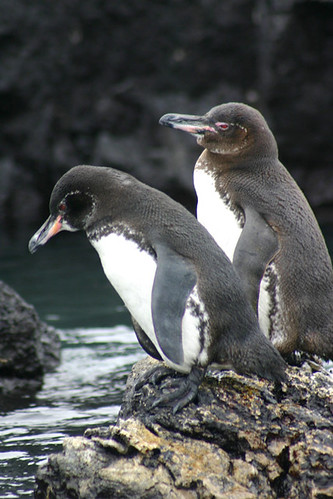




Galapagos penguin (Spheniscus mendiculus)
Facts
Kingdom Animalia
Phylum Chordata
Class Aves
Order Sphenisciformes
Family Spheniscidae
Genus Spheniscus (1)
Size Length: 53 cm (2)
Status
Classified as Endangered (EN A1bde, B1+2e+3d, C2b) on the IUCN Red List 2003 (1).
Description
The Galapagos penguin is the most northerly of all penguins, occurring on the Galapagos Islands, on the equator (3). It is the third smallest penguin in the world (4) and is the smallest member of the Spheniscidae family (5). This diminutive penguin has a black head and upperparts, with a narrow white line extending from the throat around the head to the corner of the eye (6). The underparts are white with two black bands extending across the breast (2). The upper part of the bill and the tip of the lower part of the bill are black, the rest of the bill and a bare patch around the eye and bill are pinkish yellow (6). Although the sexes are generally similar in appearance, males are larger than females (5). Juveniles have a totally dark head, and lack the dark breast bands seen in adults (2). This species has more bare skin on the face than other penguins; this is an adaptation to the hot temperatures experienced on the Galapagos (4).
Range
Endemic to the Galapagos Islands, Ecuador, with 95% of the population occurring on the western islands of Ferdinandina and Isabela, and 5% on Bartolome, Santiago and Floreana (2). This species has the smallest breeding range and lowest population numbers of all penguins (6). In 1999 the population numbered just 1,200 individuals (2).
UNEP World Conservation Monitoring Centre View a distribution map for this species at UNEP World Conservation Monitoring Centre.
Habitat
Galapagos penguins nest in burrows and depressions in volcanic deposits. They forage in the sea close to the shore during the day (5).
Biology
The Galapagos penguin has a number of unique adaptations that allow it to survive the high temperatures and unpredictable food supply of the Galapagos (4). Foraging in the sea for small schooling fish during the day helps them to avoid overheating (4). Diving takes place between the hours of 05h30 and 18h30, with short breaks on land between dives (7). Most dives are shallow and take place close to the shore (7). This species has a number of behavioural adaptations that allow these birds to keep cool on land. These include standing with the flippers extended to aid heat loss, as well as panting and seeking shade (6) (4). When standing on land they tend to adopt a strange hunched posture, which shades their bare feet, another site of heat loss, aided by increased blood flow to the bare skin (6).
Most penguins have a distinct annual breeding season at a particular time of year, but the Galapagos penguin does not. Furthermore, it may produce as many as three clutches in a single year. These adaptations help this species to cope with the highly unpredictable food resources reaching the Galapagos. The unpredictability of the ocean currents that bring small fish to the islands is compounded further by changes in water temperatures caused by El Nino events (4). The flexibility of breeding in this penguin allows it to take advantage of times of high food abundance (6). When the surface temperature of the sea becomes high, food shortages result as the water becomes very poor in nutrients. These periods are known as El Nino Southern Oscillations (ENSO). During these periods, the penguins will delay breeding completely until the food resources improve (6).
Pair bonds are for life, enabling these birds to begin breeding quickly when conditions improve. The bond is reinforced by mutual preening and bill tapping. Two eggs are produced at an interval of around four days. Incubation takes up to 40 days and is shared by the male and female. After 30 days the chicks develop plumage to protect them from the sun. After 65 days the chicks will have fledged (6).
Threats
The main threat facing this unique penguin is the fluctuations in food supply, compounded by El Nino events. The 1982-1983 El Nino Southern Oscillation (ENSO) resulted in the catastrophic loss of 77% of the population through starvation. A slow period of recovery followed, but the 1997-1998 ENSO resulted in another precipitous population crash of 66%. It is now thought that the species is experiencing another recovery phase (2). Other threats facing this beleaguered penguin include predation by introduced feral animals such as dogs and cats, increased disturbance by tourists, pollution (including oil spills), and fishing (5).
Conservation
All populations of the Galapagos penguin occur within the Galapagos National Park and Marine Reserve (2). At present, all populations are closely monitored and feral animals are controlled. Proposed measures to help this highly endangered species include discouraging the use of fishing nets in the foraging area, preventing coastal developments in the breeding areas, and providing nest-boxes in predator free areas to allow research into the reproductive success of the species (2). As the population of the diminutive and uniquely adapted Galapagos penguin is so small and precarious, and restricted to just one breeding location, unfortunately the species is extremely vulnerable to extinction (1).
References
1. IUCN Red List of Threatened Species 2003 (March 2004):
http://www.redlist.org
2. BirdLife International 2003 Birdlife’s online World Bird Database: the site for bird conservation Version 2.0. Cambridge, UK: BirdLife International (March 2004)
http://www.birdlife.net/datazone/search/species_search.html?action=SpcHTMDetails.asp&sid=3864&m=1
3. Galapagos Online (March 2004)
http://www.galapagosonline.com/Galapagos_Natural_History/Birds_and_Animals/Birds/Penguins.html
4. Chan, A. & Durham, W. (2002) Adaptations of the Galapagos penguin for a harsh and unpredictable environment. (March 2004)
http://www.stanford.edu/class/anthsci10sc/2002_galapagos_website/Albert-Penguin.htm
5. Penguin Taxon Advisory Group (March 2004)
http://www.penguintag.org/species_index_galapogos.htm
6. International Penguin Conservation Work Group (March 2004)
http://www.penguins.cl/galapagos-penguins.htm
7. MILLS, K.L. (2000). Diving behaviour of two Galapagos Penguins Spheniscus mendiculus. Marine Ornithology 28: 75–79. Available at:
http://www.marineornithology.org/PDF/28_1/28_1_12.pdf
Information courtesy of Arkive @
http://www.arkive.org/galapagos-penguin/spheniscus-mendiculus/info.html
Pictures courtesy of Flickr

















No comments:
Post a Comment